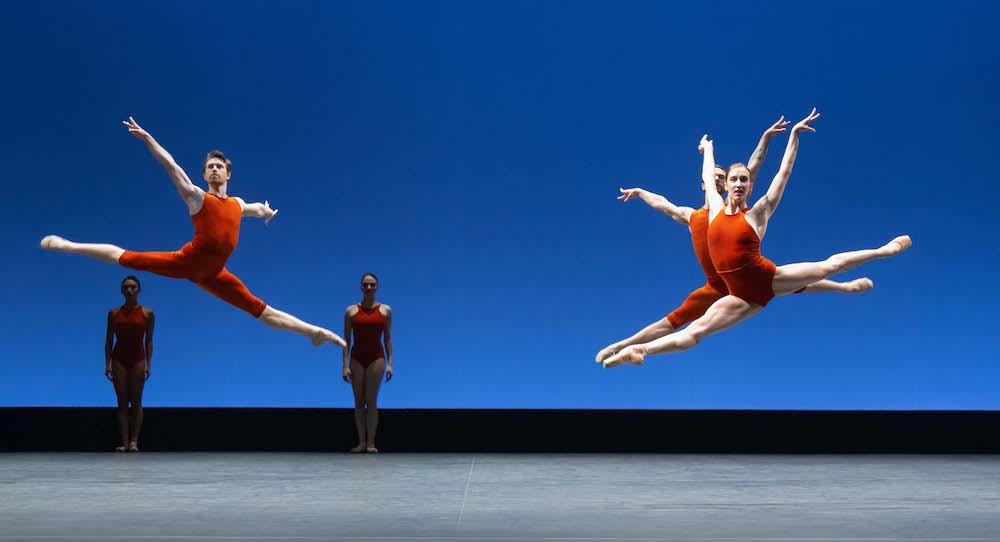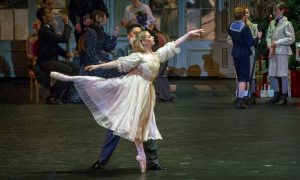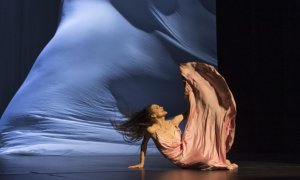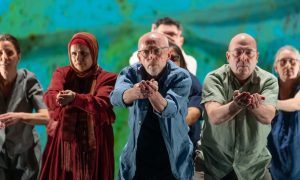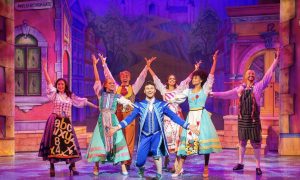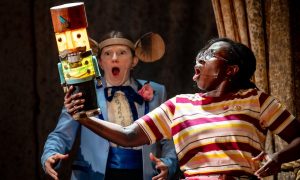Sadler’s Wells Theatre, London.
10 April 2025.
You’d have been sorry to have missed this.
The curtain opened on Act 1 of English National Ballet (ENB)’s The Forsythe Programme, revealing a black stage, simply lit. A female soloist stood centrally, one foot on pointe. She moved in silence, before being joined by two male dancers. There was music intermittently. And there was silence in which we could hear the breath of the dancers as they moved — not forced, but functional.
Rearray was a trio of intricate play, dedicated to Justin Bickle, former Chairman of ENB. There was humour and friendship between the three – and the audience. Sanguen Lee produced beautiful strong extension after extension. Enjoyably slick were the sharp blackouts, typical of William Forsythe’s taste of playing with audience expectation. Lights snapped back up with dancers in new positions, a new scene.
The t-shirts the dancers wore gave a casual, almost rehearsal-like feel at times.
The work required concentration from the viewer. It was fast, both in footwork and in the expressive hands, arm lines and gestures. Quirky, angular linking of arms, connecting the dancers and extensions through the balletic lines. An interesting piece.
A swift curtain lowered and rose again on the second part of the triple bill.
Herman Schmerman‘s ‘Quintet’ featured sharp, jangling electronic score and five dancers in red – three females on pointe – and exploded into movement. There were lots of lively executions, effortlessly showcasing incredible strength and skill, and lots of characteristic broken wrists, high jumps, high and extended leg lines.
There was a delicious casualness as dancers walked naturally on and off the stage. Acknowledging one another before dancing. Facial expressions were bright and drew the audience in. In fact, the commitment of all the dancers and their energy in manifesting the stylised choreography is what made it such a successful piece.
Herman Schmerman is a curious and entertaining mix of spiky extensions and fluidity, all about the shapes and lines, with a fun ending as dancers disappeared behind the sight line at the back of the stage. And the audience was certainly an appreciative and entertained one.
Act 2 featured Playlist (EP). This is where you’d bring somebody who’d never seen ballet before. Who thought ballet wasn’t for them. And challenge them not to tap their toe and be uplifted by the visual spectacle on stage! An eclectic selection of soul tracks filled the theatre with extraordinary energy — a reminder that music holds incredible power.
Ballet at the disco! Playlist (EP) was how ballet dancers would like to let loose on the dance floor instead of holding back to boogie with everyone else! It was slick, fast, vibrant and energetic. From the stunning presentation, you might not have realised the depth of the technically stylised work which was performed with ease.
Important to notice, Playlist had the audience behaving in an un-balletic manner. There was cheering, clapping and laughter. A unique experience for ballet dancers and the freedom that gave to them was electric to watch. Enjoyment oozed from the stage to the auditorium and back again. In Forsythe’s words, “There are so many ways to love ballet.”
The curtain rose on a stage full of men. Dazzling blue dance tights and pink t-shirts with their names emblazoned across the back, sport-team style. A gorgeous display of relaxed and rhythmic fun and virtuosity. So satisfying as they leapt as a group and synchronized pirouettes.
With each different track came a new dance, each as stunning and demanding of attention as the previous one. Female dancers on pointe, dressed in pink short dresses with full skirts that spun in response to the fast footwork and turns. A lot of ballroom and jive influences were evident in the partner work. There was an exciting and satisfying use of counterbalance, the music all the time giving permission for freedom and enjoyment.
Forsythe’s choreography showed a pattern of introducing the whole group of dancers at the start of a track, who would then leave in favour of soloist moments which thrilled the audience, before joining together again.
A real celebratory feel was sustained throughout the whole of Playlist and the huge, fast activity on stage. There was feeling of unity without individual status, much like a dance floor. Particularly effective towards the end was the filling of the stage as the entire company came together.
The curtain lowered on the continuous flow of dancing. The audience must leave as the party continued…
We’d like to see that all again, please!
By Louise Ryrie of Dance Informa.


